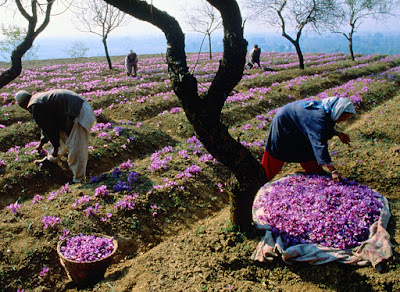Saffron appears in favorite dishes of lots of countries all
over the world. It is the best option to give fantastic color, aroma and taste
to your dishes and a good way to decorate your foods. You can make drinks and
sweets with it and take advantage of its health benefits.
Back in the history, saffron is used in Moorish,
Mediterranean and Asian cuisines. Its most common function is to give yellow
color to rice, as in festive Indian food named Pilaus and in Risotto Milanese,
where its delicate flavor make it the most famous Italian rice dish. It
combines well with fish and seafood, famous as a key ingredient of Spanish
paella as well as bouillabaisse. In England, saffron is probably best known for
its use in Cornish saffron buns where it is paired with dried fruit in a yeast
cake.
At below we put some food recipes that use saffron as an
ingredient from famous food recipe websites. You can use these recipes and our
High Quality Saffron to make memorable moments for yourself and your family.
Food recipes with saffron:
Saffron Rice with Chorizo and Peas
Read more at: http://www.foodnetwork.com/recipes/emeril-lagasse/saffron-rice-with-chorizo-and-peas-recipe.html
Lamb Chops with Pomegranate Sauce and Saffron Pilaf
Read more at: http://www.foodnetwork.com/recipes/rachael-ray/lamb-chops-with-pomegranate-sauce-and-saffron-pilaf-recipe.html?oc=linkback
Seared Mahi-Mahi with Saffron Risotto and Mango Sauce
Read more at: http://www.foodnetwork.com/recipes/seared-mahi-mahi-with-saffron-risotto-and-mango-sauce-recipe.html?oc=linkback
Saffron Rice
Read more at: http://www.foodnetwork.com/recipes/emeril-lagasse/saffron-rice-recipe.html
Saffron Basmati Rice
Chicken Scallopine with Saffron Cream Sauce
Read more at: http://www.foodnetwork.com/recipes/chicken-scallopine-with-saffron-cream-sauce-recipe.html?oc=linkback
Tagliatelle with Saffron, Seafood, and Cream
Read more at: http://www.foodnetwork.com/recipes/jamie-oliver/tagliatelle-with-saffron-seafood-and-cream-recipe.html?oc=linkback
Mussels with Saffron Mayonnaise
Read more at: http://www.foodnetwork.com/recipes/ina-garten/mussels-with-saffron-mayonnaise-recipe.html#
Linguine with Seafood in Saffron Broth
Read more at: http://www.foodnetwork.com/recipes/emeril-lagasse/linguine-with-seafood-in-saffron-broth-recipe.html?oc=linkback
Shrimp and Saffron Risotto
Read more at: http://www.foodnetwork.com/recipes/food-network-kitchens/shrimp-and-saffron-risotto-recipe.html
Roasted Leg of Lamb with Saffron and Olive Salsa
Read more at: http://www.foodnetwork.com/recipes/cat-cora/roasted-leg-of-lamb-with-saffron-and-olive-salsa-recipe.html#?oc=linkback
Pancetta and Saffron Rice
Read more at: http://www.foodnetwork.com/recipes/giada-de-laurentiis/pancetta-and-saffron-rice-recipe.html
Saffron Spaghetti alla Carbonara
Read more at: http://www.foodnetwork.com/recipes/rachael-ray/saffron-spaghetti-alla-carbonara-recipe.html
Saffron Roasted Cauliflower
Read more at: http://www.foodnetwork.com/recipes/food-network-kitchens/saffron-roasted-cauliflower.html
Veal Scaloppini with Saffron Cream Sauce
Read more at: http://www.foodnetwork.com/recipes/giada-de-laurentiis/veal-scaloppini-with-saffron-cream-sauce-recipe.html?oc=linkback
Pappardelle in Saffron Cream
Read more at: http://www.foodnetwork.com/recipes/food-network-kitchens/pappardelle-in-saffron-cream-recipe.html
Mussels and Fennel with Saffron Cream Sauce
Read more at: http://www.foodnetwork.com/recipes/emeril-lagasse/mussels-and-fennel-with-saffron-cream-sauce-recipe.html?oc=linkback
Shellfish and Chicken Paella with Saffron Rice Chorizo and Peas
A Modern Version of an Ancient Paella: Saffron Rice with Chicken, Shrimp, Stringbeans, and Snails
Read more at: http://www.foodnetwork.com/recipes/a-modern-version-of-an-ancient-paella-saffron-rice-with-chicken-shrimp-stringbeans-and-snails-recipe.html?oc=linkback
Linguine with Scallops and Snow Peas in a Saffron Sauce
Read more at: http://www.foodnetwork.com/recipes/linguine-with-scallops-and-snow-peas-in-a-saffron-sauce-recipe.html?oc=linkback
Tunisian Lamb with Saffron (Keleya Zaara)
Read more at: http://allrecipes.com/recipe/162193/tunisian-lamb-with-saffron-keleya-zaara/?internalSource=hub%20recipe&referringContentType=search%20results&clickId=cardslot%2024
Artichokes with Saffron and Almonds
Read more at: http://allrecipes.com/recipe/139613/artichokes-with-saffron-and-almonds/?internalSource=hub%20recipe&referringContentType=search%20results&clickId=cardslot%2016
Moroccan Chicken with Saffron and Preserved Lemon
Read more at: http://allrecipes.com/recipe/246488/moroccan-chicken-with-saffron-and-preserved-lemon/?internalSource=hub%20recipe&referringContentType=search%20results&clickId=cardslot%2023
Indian Saffron Rice
Read more at: http://allrecipes.com/recipe/24709/indian-saffron-rice/?internalSource=hub%20recipe&referringContentType=search%20results&clickId=cardslot%2019
Saffron Couscous
Read more at: http://allrecipes.com/recipe/240812/saffron-couscous/?internalSource=hub%20recipe&referringContentType=search%20results&clickId=cardslot%202
English Saffron Bread
Read more at: http://allrecipes.com/recipe/17097/english-saffron-bread/?internalSource=hub%20recipe&referringContentType=search%20results&clickId=cardslot%2011
Grilled Saffron Rack of Lamb
Read more at: http://www.bonappetit.com/recipe/grilled-saffron-rack-lamb
Spiced Peppers and Eggplant
Read more at: http://www.bonappetit.com/recipe/spiced-peppers-and-eggplant
Grilled Lobster Paella
Read more at: http://www.bonappetit.com/recipe/grilled-lobster-paella
Golden Corn and Saffron Polenta
Read more at: http://www.bonappetit.com/recipe/golden-corn-and-saffron-polenta
Bouillabaisse with Rouille and Garlic Toasts
Read more at: http://www.bonappetit.com/recipe/bouillabaisse-with-rouille-and-garlic-toasts
Lemon Buttermilk Pie with Saffron
Read more at: http://www.bonappetit.com/recipe/lemon-buttermilk-pie-saffron
Roast Chicken with Saffron, Hazelnuts, and Honey
Read more at: http://www.epicurious.com/recipes/food/views/roast-chicken-with-saffron-hazelnuts-and-honey-51184640
Paccheri Pasta with Braised Chicken and Saffron Cream
Read more at: http://www.epicurious.com/recipes/food/views/paccheri-pasta-with-braised-chicken-and-saffron-cream-360710
Sautéed Fennel with Almonds, Raisins, and Saffron
Read more at: http://www.epicurious.com/recipes/food/views/sauteed-fennel-with-almonds-raisins-and-saffron-243631











































